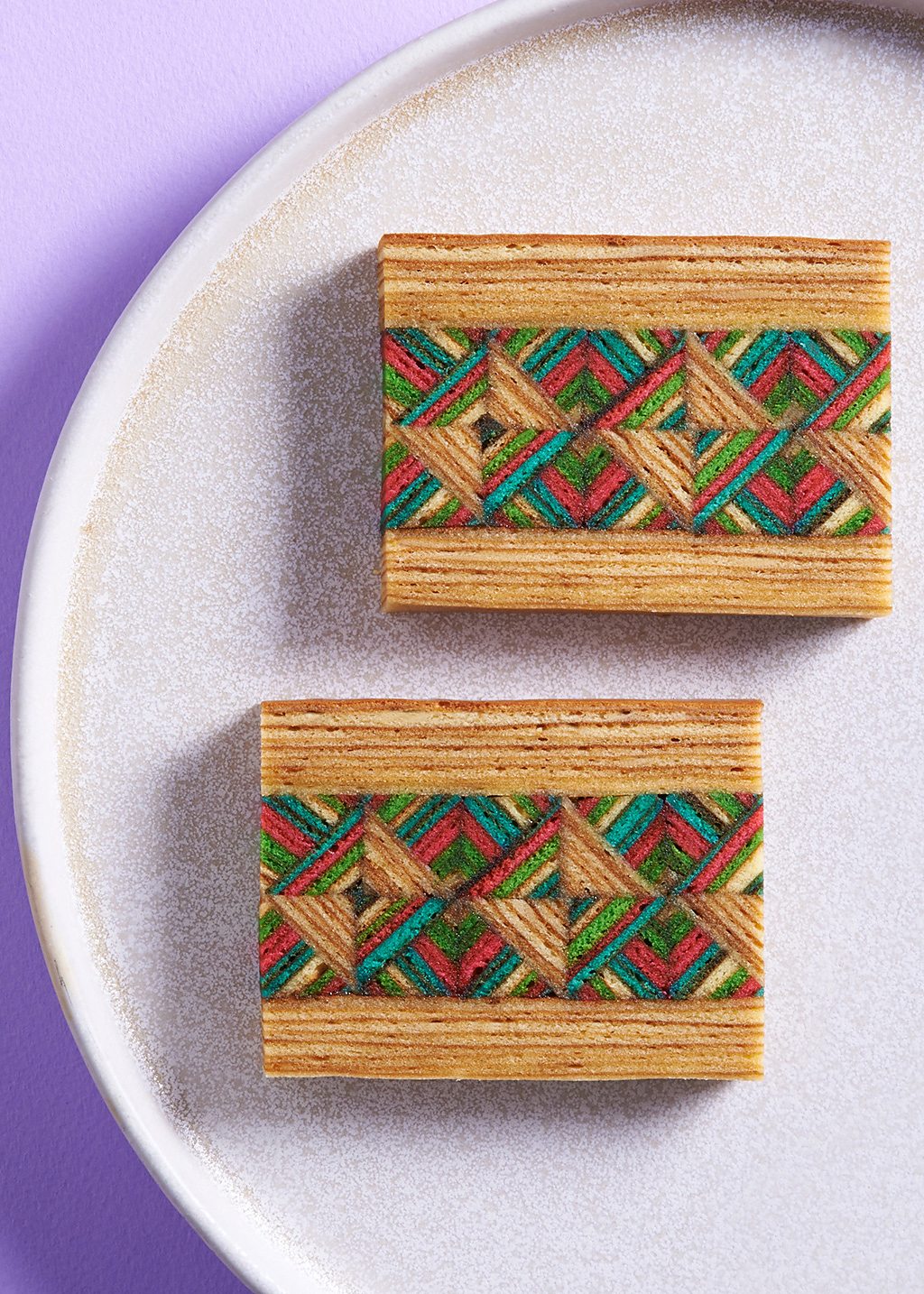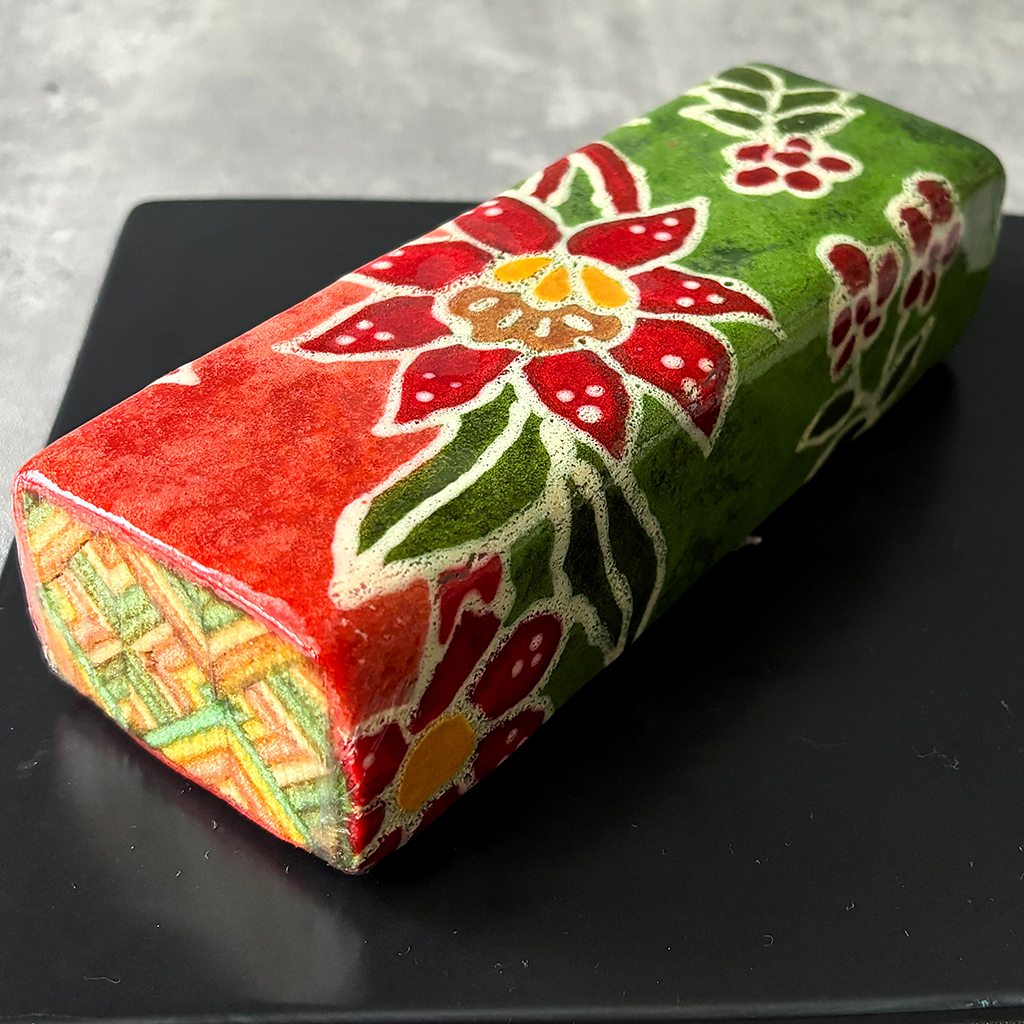
The cake is a sublime art form, involving numerous colours and flavours commingling into an oh-so-soft and delicious cake that hides a kaleidoscope of intricate geometric patterns.
The rich, buttery aroma of kek lapis (layer cake) greets me when I walk into Seri's (short for Sharifah Zainon) small baking studio at her home near Kuala Lumpur. The alluring aroma is not surprising, given that Malaysia is gearing up to celebrate Raya, the local name for Ramadan, and kek lapis is an integral part of these festivities.
Seri puts her academic training as an engineer to good use in her current career as a baker. Watching her hands spreading the batter evenly on the pan, I think that baking a kek lapis is a bit like conducting a scientific experiment. Preparing this multi-layered Malaysian cake with colourful and complex patterns not only requires knowledge and skill, but also oodles of patience, an eye for precision and a steady hand.
A degree in the sciences seems to come in handy for kek lapis bakers, seeing the elaborate designs that Karen Chai, another engineer turned baker, creates at her baking studio in a quiet Kuala Lumpur suburb. When Chai returned to Malaysia after studying pastry arts at Le Cordon Bleu in Paris, she decided to focus on kek lapis, using her mother's recipe as a starting point. "Learning about the science of baking has been very useful in making kek lapis," she said.
This layer cake first came to Malaysia from neighbouring Indonesia through the state of Sarawak on the island of Borneo. In the mid-19th Century, Dutch colonisers introduced the plain European spit cake – made with layers of dough deposited one by one onto a cylindrical rotating spit – to the nation then known as Batavia (now Jakarta). Indonesians added local spices such as cinnamon, cloves and nutmeg and turned it into the lapis legit, often known as the thousand-layer cake.

Upon its arrival in neighbouring Malaysia in the 1970s, Sarawakians elevated the cake to a sublime art form, involving multiple layers and numerous colours and flavours commingling into the oh-so-soft and delicious kek lapis. While the classic kek lapis often looks like a plain loaf on the outside, cutting it reveals a kaleidoscope of intricate geometric patterns.
Also called the Sarawak layer cake, kek lapis typically has a minimum of 12 layers. The cake is created by carefully adding one thin layer of batter after another onto a baking pan every few minutes, broiling (or grilling) each layer in the oven to ensure the lower layers are never burnt. The plain version alternates light and dark strips of cake batter, whereas the coloured cakes have geometric patterns that, depending on the final pattern, can involve 20 or more layers.
The final cake is cooled and then cut into strips, with different pieces reassembled using thick jam or condensed milk as adhesive. Often, multiple cakes have to be baked, and pieces from each of them are assembled to create a complex pattern. This is then wrapped up in a thin cake layer of a single colour, or arranged between two sets of plain (ie, with no colours or patterns) multi-layered cakes.
If all this sounds confusing, then imagine what it is like for the baker. Even the most experienced of them first draws these patterns on paper, clearly marking out sizes and colours, after which they get to work with the batter. A complex design can take up to eight hours to complete, with several chances for error at every step in the assembly process.

Chai explains that as opposed to other complex layered cakes, it is particularly tough with kek lapis, since the error often becomes apparent only after the baker has finished assembling the pieces, "so all the hard work goes down the drain".
She then shows me photos of her mother's signature 16-piece design that was born out of an error in calculation. "She baked a few extra layers by mistake and didn't want to throw those pieces away. She just cut that up and tried to form another block, and this design came out. So this is not something that you will find from other bakers," she said.
Both Seri and Chai say that the long and laborious baking process is worth the reward of seeing a perfectly executed design. "But there are no short cuts," Chai warned. Indeed, seeing Seri at work, cutting and sticking these long strips together with a generous lashing of raspberry jam, brings to mind a complicated jigsaw puzzle slowly taking shape. "It's like therapy, [but] it's also fun and creative" she said.
When I visited in mid-February, the bakers had been working non-stop for weeks, fulfilling Raya orders received through their social media channels. Back in their hometowns in Sarawak, kek lapis is part of every holiday celebration, including Chinese New Year, Raya, Christmas and the midyear harvest festival of Gawai Dayak, cutting across communal and religious boundaries.

Seri's long-term client and self-professed cake lover, Farazaila Wahet, said, "This is an anytime cake for me, but of course for Raya, it is a must." The Sarawak native, who moved to Kuala Lumpur more than 10 years ago, said that the satisfaction she gets from kek lapis is unparalleled, because "the texture is heavier and the taste is richer compared to any other cake."
Kek lapis is available in many flavours, such as chocolate, vanilla, strawberry, red velvet and pandan (a tropical plant with a strong aroma, commonly used in Southeast Asian cooking). Even popular malted drinks like Horlicks and Milo are used for flavouring. And now, artisanal bakers like Seri and Chai are trying to modernise this traditional cake to make it relevant to younger generations, while also staying true to the original recipe.
Seri, for instance, makes exquisite chocolate batik art on the top layer to make her cakes even more attractive. "Batik is traditional to Malaysia, so is kek lapis, and I love to combine the two to create this new version," she said.
More like this:
• A multi-layered cake from India
• Norway's best cake
• The centuries-old baba made with 96 egg yolks
Chai keeps experimenting not just with more complicated patterns, but also new ingredients and flavour pairings. In the past, she has created gluten-free kek lapis using coconut flour with peanut butter topping, and another unique version with fig, apricot and cinnamon.
Baking a good kek lapis requires a lot of time and high-quality ingredients, which means that they are also expensive, with prices going up to RM300 (roughly £50) or more for a square, one-kilogram cake. But thankfully for the small-batch bakers, this traditional cake is constantly in demand from individual clients and it's also gaining in popularity as corporate gifts and wedding favours.
These bakers are on a mission to maintain this Sarawak culinary tradition, despite all the long hours and thin margins. As Seri said, "Every time I make a kek lapis, it feels like a piece of home to me."
BBC.com's World's Table "smashes the kitchen ceiling" by changing the way the world thinks about food, through the past, present and future.
---
Join more than three million BBC Travel fans by liking us on Facebook, or follow us on Twitter and Instagram.
If you liked this story, sign up for The Essential List newsletter – a handpicked selection of features, videos and can't-miss news delivered to your inbox every Friday.
https://news.google.com/rss/articles/CBMiWWh0dHBzOi8vd3d3LmJiYy5jb20vdHJhdmVsL2FydGljbGUvMjAyNDA0MDYta2VrLWxhcGlzLXRoZS1tb3N0LWJlYXV0aWZ1bC1jYWtlLWZvci1yYW1hZGFu0gEA?oc=5
2024-04-06 13:38:45Z
Bagikan Berita Ini














0 Response to "Kek lapis: The most beautiful cake for Ramadan - BBC.com"
Post a Comment